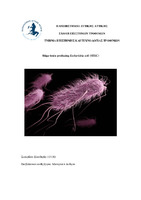| dc.contributor.advisor | Batrinou, Anthimia | |
| dc.contributor.author | Σταυρίδου, Ελευθερία | |
| dc.date.accessioned | 2023-03-09T12:07:12Z | |
| dc.date.available | 2023-03-09T12:07:12Z | |
| dc.date.issued | 2023-02-21 | |
| dc.identifier.uri | https://polynoe.lib.uniwa.gr/xmlui/handle/11400/3858 | |
| dc.identifier.uri | http://dx.doi.org/10.26265/polynoe-3698 | |
| dc.description.abstract | Η E. coli αποτελεί τη κυρίαρχη μη παθογόνο χλωρίδα του ανθρώπινου και ζωικού
εντέρου και βοηθά στην παραγωγή βιταμινών , ανταγωνίζεται και καταστέλλει την
ανάπτυξη παθογόνων βακτηρίων.
Η συγκεκριμένη μελέτη που θα ακολουθήσει αφορά έναν από τους έξι παθότυπους που
κατηγοριοποιείται η Ε. coli, την Shiga toxin-producing Escherichia coli.
Τα εντεροτοξινογόνα στελέχη της STEC τα οποία παράγουν Shiga τοξίνες (Stx),
αποτελούν ένα συχνά εμφανιζόμενο τροφιμογενή παθογόνο παράγοντα από τα πιο
παλιά χρόνια μέχρι και τώρα που προέρχεται κυρίως από τα ζώα , από λανθασμένη
μεταχείριση αυτών , του χώρου που αυτά κατοικούν και του χειριστή αυτών. Εμφανίζει
ιδιαίτερο ενδιαφέρον λόγω του γενετικού της χαρακτήρα ο οποίος επηρεάζει τόσο την
παθογένεια της όσο την εμφάνιση της στα τρόφιμα, στο νερό και στο περιβάλλον αλλά
ακόμα τις διαδικασίες ελέγχου πρόληψης και απομόνωσης της. Εξαιτίας των κρίσιμων
και σοβαρών παθήσεων που ενδέχεται να προκαλέσει στους ανθρώπους και στα ζώα,
λόγω της παραγωγής Shiga τοξίνης, παρουσιάζει ιδιαίτερο επιστημονικό ενδιαφέρον
που αξίζει να αναλυθεί στην συγκεκριμένη εργασία. Τα συμπτώματα της λοίμωξης από
κάποιο στέλεχος της STEC ποικίλουν ανάλογα με το άτομο που νοσεί και πολλές φορές
ανάλογα και με την πηγή μόλυνσης , γεγονός που απασχολεί τους ερευνητές και
προκαλεί ακόμα και σήμερα πρόκληση η κατανόηση της και η ανίχνευση της σε
σύντομο χρόνο ώστε να αποφευχθεί η διασπορά της.
Απώτερος σκοπός της μελέτης αυτής είναι η εκτίμηση των επιπτώσεων της μόλυνσης
από STEC στους ανθρώπους και η συσχέτισή της με τον επιπολασμό του παθογόνου
στο ζωικό πληθυσμό, σε προϊόντα ζωικής και φυτικής προέλευσης με σκοπό την
κατανόηση της και τον έλεγχο της σε επίπεδο παραγωγής αλλά και προσωπικο | el |
| dc.format.extent | 73 | el |
| dc.language.iso | el | el |
| dc.publisher | Πανεπιστήμιο Δυτικής Αττικής | el |
| dc.rights | Αναφορά Δημιουργού - Μη Εμπορική Χρήση - Παρόμοια Διανομή 4.0 Διεθνές | * |
| dc.rights | Attribution-NonCommercial-NoDerivatives 4.0 Διεθνές | * |
| dc.rights.uri | http://creativecommons.org/licenses/by-nc-nd/4.0/ | * |
| dc.subject | Τοξίνες | el |
| dc.subject | Shiga | el |
| dc.subject | Escherichia coli | el |
| dc.subject | ISO | el |
| dc.title | Escherichia coli που παράγει Shiga-τοξίνη | el |
| dc.title.alternative | Shiga-toxin producing Escherichia coli | el |
| dc.type | Πτυχιακή εργασία | el |
| dc.contributor.committee | HOUHOULA, DIMITRA | |
| dc.contributor.committee | Αντωνόπουλος, Διονύσιος | |
| dc.contributor.faculty | Σχολή Επιστημών Τροφίμων | el |
| dc.contributor.department | Τμήμα Επιστήμης και Τεχνολογίας Τροφίμων | el |
| dc.description.abstracttranslated | E. coli is the predominant non-pathogenic flora of the human and animal gut and assists
in the production of vitamins and competes with and suppresses the growth of
pathogenic bacteria.
The specific study that will follow concerns one of the six passive E. coli categorized,
Shiga toxin-producing Escherichia coli.
The enterotoxigenic strains of STEC that produce Shiga toxins (Stx) are a frequently
occurring foodborne pathogen from the earliest years until now, which mainly
originates from animals, from incorrect treatment of them, the space they live in and
their operator . It is of particular interest due to its genetic character, which affects both
its pathogenicity and its appearance in food, water and the environment, but also its
prevention control and isolation procedures.
Because of the critical and serious diseases it may cause in humans and animals, due to
the production of Shiga toxin, it is of particular scientific interest that deserves to be
analyzed in this paper. The symptoms of infection by a strain of STEC vary depending
on the person who is sick and often depending on the source of infection, a fact that
worries researchers and even today causes a challenge to understand it and to detect it
in a short time in order to avoid it its dispersion.
The ultimate aim of this study is to assess the effects of STEC infection in humans and
its correlation with the prevalence of the pathogen in the animal population, in products
of animal and plant origin with the aim of understanding it and controlling it at the
production level as well as personal | el |


